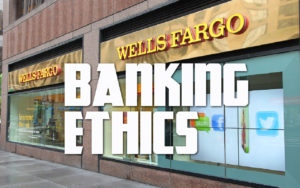Wells Fargo was caught red-handed when their bank employees were pressured to open as many as two million banking and credit card accounts without customers’ knowledge. The pressure was applied directly from above to the retail banking employees with threats that if they didn’t produce, they would be out of jobs. Banking ethics are at the forefront of this scandal and not likely  something that Wells Fargo thought much about when the actions of the retails banking folks were cranking fake sales.
something that Wells Fargo thought much about when the actions of the retails banking folks were cranking fake sales.
In an industry marked by mistrust and misdeeds, the Wells Fargo scandal set a new low for unethical behavior and fraud.
Wells Fargo: The Consequences
The financial impact of the settlement was “modest” to the bank; a $185 million settlement. The damages were acceptable, but that is not what angered those affected by the scandal. There were two culprits who directed the pressure on the employees and who defrauded those who held the accounts: John G. Stumpf, the former chief executive officer and Carrie Tolstedt, the former head of retail banking. When they were forced to resign for their unethical behavior, they had to give up $60 million in stock.
However, both of these fraudsters were sitting on “Golden Parachutes” amounting to more than $350 million! In a major reversal, the bank regulators revoked Wells Fargo’s right to shield the pay of former executives. Therefore, the executives could lose all or part of the compensation packages.
The initial settlement stated that the executives could have “relief from specific requirements and limitations regarding rules, policies, and procedures for corporate activities,” and now that protection no longer exists. Some say this is too little too late.
In addition, the regulators want tougher and tighter oversight on the people that Wells Fargo puts into the positions. The consequences of the actions of the top executives of the banking conglomerate will reverberate through the organization for many years to come.
Banking Ethics: The Heart of the Matter
The key issue in the Wells Fargo settlement has gone unstated and it is almost as if it is too painful an introspection for the bank to acknowledge. How did this happen? There are more than 265,000 employees in the Wells Fargo organization plus millions of shareholders of their stock.
How is it that two million fake accounts were opened, and that lower-ranked employees were more or less forced to make quotas or get fired? What was the environment at Wells Fargo that was created to foster such wide-scale fraud? I don’t use the word “foster” lightly, for I cannot believe that the two executives in question were the only individuals in the organization aware of the fraud. I am sure there were whistle-blowing attempts and I’ve no doubt that good, decent, moral people lost their jobs because they refused to go along with the deceptions. Therefore one wonders who knew of the pressures to open accounts and did nothing and who stood by as good people were being terminated.
At the heart of the matter is that there were no checks and balances, no ethical oversight, no sense of ownership, right or wrong or common decency. Then, to add insult to injury, the two key executives in this scandal were going to make off with more than $350 million after an admission of guilt.
I always like to ask myself some basic questions, such as would ethical training have helped the Wells Fargo organization? I am skeptical if the fraudsters at the top might have been swayed, but those under them might have been swayed to doing the right thing especially if there had been an open and empowering work environment.
Without good ethics, organizations invariably fail. For within an unethical framework, good people quit, anger lingers and a sense of dissatisfaction and discontent spreads throughout the organization. The mere fact that the organization was willing to award the two scoundrels such a huge sum of money was proof enough of a sick environment.
The culture has no choice but to change. If not, their unethical web will choke them all.
YOUR COMMENTS ARE WELCOME!


